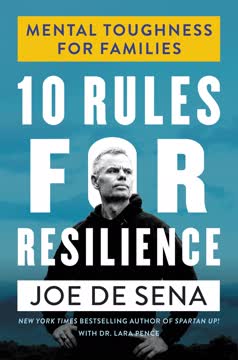Key Takeaways
1. Embrace discomfort to build true resilience
True resilience develops from a body and mind that have been carved out of challenge and failure.
Comfort is the enemy of growth. True resilience is the ability to not only withstand adversity but to use it as a catalyst for personal development. It's about embracing discomfort and pushing through challenges, rather than avoiding them. This kind of resilience is built through:
- Voluntary exposure to difficult situations
- Practicing delayed gratification
- Overcoming self-imposed limitations
By consistently choosing the hard path over the easy one, you develop the mental and physical fortitude to handle life's inevitable challenges. This approach to building resilience applies not just to adults, but to children as well. Encouraging kids to face and overcome obstacles helps them develop the grit and determination they'll need throughout life.
2. Overcome self-imposed limitations and learn delayed gratification
How do you eat an elephant? One bite at a time.
Break big goals into small steps. Overcoming self-imposed limitations starts with recognizing and challenging the stories we tell ourselves about what we can and cannot do. The key is to:
- Identify limiting beliefs
- Take small, consistent actions towards your goals
- Celebrate progress, no matter how small
Learning delayed gratification is crucial for long-term success. The famous "marshmallow experiment" demonstrated that children who could resist immediate rewards for greater future benefits tended to have better life outcomes. To cultivate this skill:
- Practice waiting for rewards
- Set long-term goals and work towards them consistently
- Teach children the value of patience and perseverance
3. Eliminate excuses and commit to a no-bullshit lifestyle
You have two options when you face an unexpected obstacle. You can put your head down and shut out the world, pretend that difficult roadblock isn't there, or you can rise, look up, and take those obstacles head-on.
Action trumps excuses. A no-bullshit lifestyle means taking responsibility for your actions and outcomes, rather than making excuses or blaming external factors. This approach involves:
- Recognizing and eliminating self-sabotaging behaviors
- Focusing on solutions rather than problems
- Being honest with yourself and others about your capabilities and limitations
By committing to this mindset, you create a foundation for personal growth and achievement. It's about facing reality head-on and taking decisive action, even when it's uncomfortable or challenging.
4. Live your values and create a family vision statement
As a family, we . . .
Define your family's core values. Creating a family vision statement helps align everyone's goals and priorities. It serves as a guide for decision-making and behavior. To create an effective vision statement:
- Gather the whole family and brainstorm shared values
- Discuss and define what's truly important to your family
- Craft a concise statement that reflects these values
- Display the statement prominently and refer to it often
Living your values means more than just talking about them – it requires consistent action and modeling the behavior you want to see in your children. This approach helps create a strong family identity and provides a framework for navigating life's challenges together.
5. Fail forward and cultivate a growth mindset
When we overprotect children, we harm them. We make it far more likely that those children will be unable to cope with such events when they leave our protective umbrella.
Embrace failure as a learning opportunity. Developing a growth mindset means viewing challenges and failures as opportunities for growth rather than as fixed limitations. This mindset is crucial for building resilience and achieving long-term success. To cultivate a growth mindset:
- Encourage effort over outcome
- Praise the process, not just the result
- Teach children to view mistakes as learning experiences
Failing forward means using setbacks as stepping stones to improvement. By reframing failure as a necessary part of growth, you can build the confidence and resilience needed to tackle bigger challenges and achieve your goals.
6. Establish a daily routine for success and model good behavior
Routine is difficult to establish in the best of times. So what happens when shit hits the fan?
Consistency is key. A well-structured daily routine provides the framework for building discipline, achieving goals, and managing stress. To create an effective routine:
- Set consistent wake-up and bedtime hours
- Include time for physical activity, self-care, and personal growth
- Be flexible enough to adapt to unexpected challenges
Modeling good behavior is crucial, especially for parents. Children learn more from what you do than what you say. By consistently demonstrating the habits and values you want to instill, you create a powerful example for your children to follow.
7. Develop discipline and responsibility through consistent action
External discipline eventually goes inside children and becomes self-discipline.
Actions build character. Discipline and responsibility are essential traits for success in all areas of life. These qualities are developed through consistent practice and reinforcement. To foster discipline and responsibility:
- Assign age-appropriate chores and tasks
- Hold children accountable for their commitments
- Teach the value of hard work and delayed gratification
By consistently following through on commitments and taking responsibility for your actions, you build the self-discipline needed to achieve long-term goals and overcome obstacles.
8. Reconnect with nature and prioritize physical activity
The best gym is the natural world.
Nature is a powerful teacher. Spending time in nature and engaging in regular physical activity are crucial for both physical and mental well-being. The benefits include:
- Reduced stress and anxiety
- Improved cognitive function
- Enhanced physical fitness and resilience
To incorporate more nature and physical activity into your life:
- Plan regular outdoor activities for the whole family
- Limit screen time and encourage active play
- Use nature as a classroom for learning and personal growth
By prioritizing connection with the natural world and regular physical activity, you build a stronger, more resilient body and mind.
9. Face your fears and nurture raw courage in yourself and your children
Fear is just a feeling. And all feelings are just emotions, not facts that are set in stone.
Courage is action in the face of fear. Developing raw courage means learning to act despite fear, rather than trying to eliminate fear altogether. To nurture courage in yourself and your children:
- Acknowledge and name fears
- Encourage facing challenges head-on
- Celebrate acts of bravery, no matter how small
Teaching children to manage their fears and take courageous action builds resilience and self-confidence. By modeling courageous behavior and providing opportunities for children to face their fears in a supportive environment, you help them develop the emotional tools they'll need to navigate life's challenges.
Last updated:
FAQ
What is "10 Rules for Resilience: Mental Toughness for Families" by Joe De Sena about?
- Focus on True Resilience: The book is a practical guide to building mental toughness and resilience in families, especially parents and children, through ten actionable rules.
- Transformation Through Adversity: Joe De Sena, founder of Spartan, shares personal stories and lessons learned from extreme endurance events, parenting, and business, emphasizing that resilience is forged through facing and overcoming challenges.
- Family-Centered Approach: The book addresses how parents can model and instill resilience in their children, making the next generation stronger and more prepared for life's obstacles.
- Actionable Framework: Each chapter presents a rule, explains its importance, and provides strategies for both adults and kids to implement resilience-building habits in daily life.
Why should I read "10 Rules for Resilience: Mental Toughness for Families" by Joe De Sena?
- Practical Parenting Advice: The book offers concrete steps for parents to help their children develop grit, responsibility, and adaptability in a world that often prioritizes comfort and ease.
- Real-Life Examples: Joe De Sena and co-author Dr. Lara Pence share relatable stories and case studies, making the advice accessible and actionable.
- Addresses Modern Challenges: The book tackles issues like overparenting, screen addiction, entitlement, and the decline of physical activity, providing solutions for today's families.
- Builds Lifelong Skills: Readers will learn how to foster resilience, discipline, and a growth mindset—skills that benefit both children and adults throughout life.
What are the key takeaways from "10 Rules for Resilience: Mental Toughness for Families"?
- Resilience Is Built, Not Bought: True resilience comes from facing discomfort, failure, and adversity, not from avoiding challenges or seeking shortcuts.
- Parents Set the Example: Children learn resilience by watching their parents handle setbacks, model discipline, and embrace hard work.
- Growth Mindset Over Fixed Mindset: Encouraging effort, learning from mistakes, and valuing process over perfection are essential for developing grit.
- Routine, Responsibility, and Risk: Daily routines, clear boundaries, and opportunities for risk-taking and failure are crucial for building strong, adaptable families.
What are the "10 Rules for Resilience" outlined by Joe De Sena in the book?
- Rule 1: You Can’t, Until You Can: Build a better belief system by challenging self-imposed limitations and encouraging family members to attempt hard things.
- Rule 2: Earned, Not Given: Emphasize the value of hard work and delayed gratification, teaching that rewards must be earned, not handed out.
- Rule 3: Commit to No Bullshit: Eliminate excuses, excess, and self-deception to foster accountability and honesty.
- Rule 4: Live Your Values: Define and communicate your family’s core values as a guiding “true north” for decisions and behavior.
- Rule 5: Fail Forward: Embrace failure as a necessary part of growth, using setbacks as learning opportunities.
- Rule 6: Dedicate to a Daily Routine: Establish consistent routines and habits to build discipline and reduce anxiety.
- Rule 7: Discipline Breeds Responsibility: Teach responsibility and integrity through consistent boundaries, chores, and modeling.
- Rule 8: Into the Wild: Prioritize physical activity and time in nature, while resisting the lure of screens and devices.
- Rule 9: Raw Courage: Confront and manage fear by taking action, not avoidance, and teaching kids to do the same.
- Rule 10: Ready for Anything: Develop grit and perseverance to prepare for life’s unpredictability and challenges.
How does Joe De Sena define "true resilience" in "10 Rules for Resilience"?
- Beyond Endurance: True resilience is not just surviving adversity but using it as an opportunity for growth and transformation.
- Embracing Discomfort: It involves seeking out and embracing discomfort, rather than avoiding it, to build mental and physical toughness.
- Consistent Character Trait: True resilience becomes a part of one’s character, influencing decisions and actions in all areas of life.
- Family and Community Impact: It’s a quality that benefits not just individuals but entire families and communities, especially when modeled and taught to children.
What is the role of parents in building resilience according to "10 Rules for Resilience"?
- Modeling Behavior: Parents must embody the resilience, discipline, and values they wish to see in their children, as kids learn primarily by example.
- Setting Boundaries and Expectations: Consistent rules, routines, and consequences help children develop responsibility and self-discipline.
- Allowing Struggle and Failure: Parents should resist the urge to overprotect or rescue their children from discomfort, instead allowing them to face challenges and learn from failure.
- Encouraging Risk and Independence: By supporting risk-taking and independence, parents help children build confidence and adaptability.
How does "10 Rules for Resilience" address overparenting and its effects?
- Identifies Overparenting Patterns: The book critiques helicopter, snowplow, and bubble-wrap parenting styles that shield children from adversity.
- Consequences of Overprotection: Overparenting leads to children who are less resilient, more anxious, and unprepared for real-world challenges.
- Promotes Healthy Struggle: De Sena advocates for letting kids experience discomfort, risk, and even failure as essential for growth.
- Practical Strategies: The book offers exercises and examples for gradually increasing children’s exposure to challenge and responsibility.
What practical methods does "10 Rules for Resilience" suggest for teaching delayed gratification and hard work?
- Marshmallow Test Analogy: The book references the Stanford marshmallow experiment to illustrate the importance of teaching patience and self-control.
- Earning Rewards: Children are encouraged to work toward goals over time, rather than receiving instant rewards or participation trophies.
- Chore and Allowance Systems: Implementing multi-step goals, chore charts, and visual progress trackers (like marble jars) help kids see the value of effort.
- Family Challenges: The book suggests family-wide challenges (e.g., cold showers, reading goals, physical feats) to practice delayed gratification together.
How does "10 Rules for Resilience" recommend handling failure and fostering a growth mindset?
- Normalize and Reframe Failure: Failure is presented as a necessary and valuable part of learning, not something to be avoided or feared.
- Growth vs. Fixed Mindset: The book draws on Carol Dweck’s research, encouraging families to praise effort and process rather than innate talent or intelligence.
- Constructive Criticism: Parents are advised to give honest, supportive feedback and to model learning from their own mistakes.
- Encourage New Experiences: Regularly trying new things and reflecting on past successes helps children and adults build confidence in their ability to grow.
What strategies does "10 Rules for Resilience" offer for reducing screen time and increasing physical activity in families?
- Lead by Example: Parents are urged to limit their own device use and prioritize outdoor activities and exercise.
- Precommitments and Earning Screen Time: Children must complete chores, homework, and physical activity before accessing screens.
- Make Movement Fun: The book suggests incorporating play, sports, and family adventures into daily routines to make physical activity enjoyable.
- Highlighting Health Risks: De Sena discusses the negative effects of excessive screen time and sedentary behavior, motivating families to make healthier choices.
How does "10 Rules for Resilience" help families define and live by their core values?
- Vision Statement Exercise: The book provides step-by-step guidance for families to identify and articulate their shared values in a concise, memorable statement.
- Daily Integration: Families are encouraged to display their vision statement and refer to it when making decisions or resolving conflicts.
- Modeling Values: Parents must consistently demonstrate the values they espouse, both at home and in public.
- Flexibility and Re-evaluation: The book acknowledges that values may evolve and encourages families to revisit and revise their vision statement as needed.
What are the best quotes from "10 Rules for Resilience" and what do they mean?
- "Choose your hard." – Life is inherently difficult, whether you choose the discomfort of growth or the pain of stagnation. The choice is yours.
- "You can’t, until you can." – Limitations are often self-imposed; with effort and persistence, what once seemed impossible becomes achievable.
- "Earned, not given." – True satisfaction and self-esteem come from working for rewards, not receiving them without effort.
- "Resilience is the ability to respond to some kind of adversity as if the adversity didn’t happen." – The most resilient people adapt and keep moving forward, using challenges as opportunities for growth.
- "When they go easy, we go hard." – In a world that often seeks comfort, choosing the harder path builds strength, character, and lasting fulfillment.
Review Summary
10 Rules for Resilience receives mostly positive reviews, with readers praising its practical advice on building resilience in children and adults. Many appreciate the straightforward approach and actionable tips provided. Parents find the book particularly helpful, noting its emphasis on allowing children to face challenges and develop grit. Some readers mention the author's occasional use of strong language but still recommend the book. Critics argue that some examples are overly simplistic, and a few view it as marketing for Spartan Race.
Similar Books


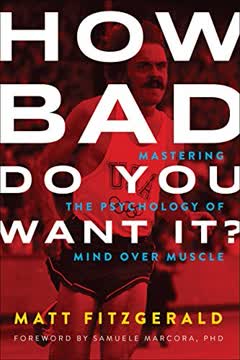
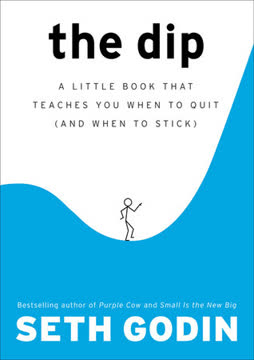

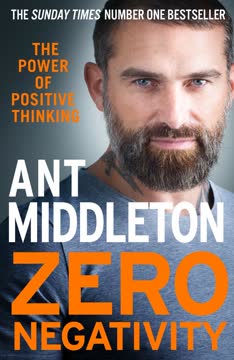

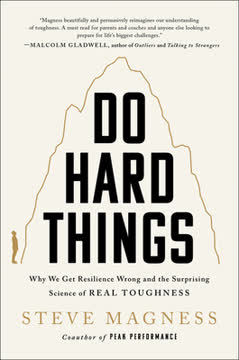
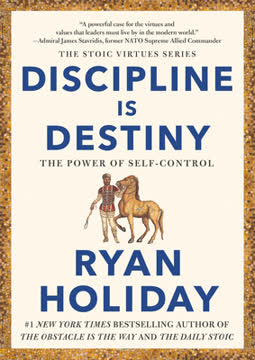
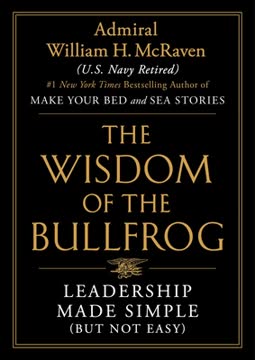
Download PDF
Download EPUB
.epub digital book format is ideal for reading ebooks on phones, tablets, and e-readers.
